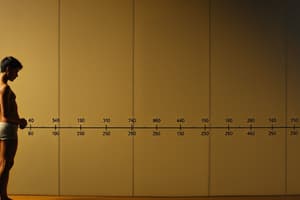Podcast
Questions and Answers
What is the correct initial step to take when correcting a shift in the lumbar area?
What is the correct initial step to take when correcting a shift in the lumbar area?
- Assess in all planes (lumbar)
- Apply direct force to the left to take away right shift
- Use your body to shift trunk and stab hip (correct)
- Determine reaction when irritability is low
Why is it important to perform an examination in the same order when assessing spinal movements?
Why is it important to perform an examination in the same order when assessing spinal movements?
- To assess all planes of movement (lumbar)
- To determine reaction when irritability is low
- To watch for deviations (correct)
- To assess segmental mobility of the spine
What should be done to close the foraminal space and compromise the facets during the assessment?
What should be done to close the foraminal space and compromise the facets during the assessment?
- Quadrant extension, rotation, and side bending (correct)
- Assess in all planes (lumbar)
- Perform a segmental mobility assessment
- Apply direct force to the left to take away right shift
When assessing spinal movements, what should be done if pain occurs or is relieved?
When assessing spinal movements, what should be done if pain occurs or is relieved?
Why is it essential to put thought into the order of examination steps?
Why is it essential to put thought into the order of examination steps?
Which position is recommended for performing pelvic joint mobility testing according to the text?
Which position is recommended for performing pelvic joint mobility testing according to the text?
What type of sensation should be expected when gently pushing on the sacrum during assessment?
What type of sensation should be expected when gently pushing on the sacrum during assessment?
What is the significance of the 'driving a bus' analogy mentioned in the text?
What is the significance of the 'driving a bus' analogy mentioned in the text?
Why is palpation with movement considered crucial during pelvic assessment?
Why is palpation with movement considered crucial during pelvic assessment?
Which test involves the PT's hands on the apex of the sacrum and gentle downward pressure?
Which test involves the PT's hands on the apex of the sacrum and gentle downward pressure?
What is the benefit of conducting examinations in an order that minimizes position changes for the patient?
What is the benefit of conducting examinations in an order that minimizes position changes for the patient?
What is the purpose of performing ROM of the lumbar spine and quadrant testing in patients with stiffness/abnormalities?
What is the purpose of performing ROM of the lumbar spine and quadrant testing in patients with stiffness/abnormalities?
During palpation, what should be checked early on to assess for symmetry?
During palpation, what should be checked early on to assess for symmetry?
What is the purpose of the Gillette test mentioned in the text?
What is the purpose of the Gillette test mentioned in the text?
In the context of leg length assessment, what role does hooklying position play?
In the context of leg length assessment, what role does hooklying position play?
What is the significance of keeping hands on PSIS while a patient performs forward flexion or extension?
What is the significance of keeping hands on PSIS while a patient performs forward flexion or extension?
Why is it important to compare the ASIS to med malleoli measurement side to side in jnt mobility assessment?
Why is it important to compare the ASIS to med malleoli measurement side to side in jnt mobility assessment?
What is the primary difference between natural observation and formal observation in a physical examination?
What is the primary difference between natural observation and formal observation in a physical examination?
What aspect is crucial during posture assessment in a physical examination?
What aspect is crucial during posture assessment in a physical examination?
How can a healthcare provider differentiate between protective and habitual list in a patient's physical examination?
How can a healthcare provider differentiate between protective and habitual list in a patient's physical examination?
In scoliosis, how can structural scoliosis be distinguished from functional scoliosis?
In scoliosis, how can structural scoliosis be distinguished from functional scoliosis?
What does a lateral shift towards the right indicate in the context of a patient with a herniated disc?
What does a lateral shift towards the right indicate in the context of a patient with a herniated disc?
How can a lateral shift towards the left be explained in a patient with a herniated disc?
How can a lateral shift towards the left be explained in a patient with a herniated disc?
What is the purpose of performing muscle length testing during a lumbar examination?
What is the purpose of performing muscle length testing during a lumbar examination?
In a lumbar examination, what does PAIVMS stand for?
In a lumbar examination, what does PAIVMS stand for?
What is the recommended sequence when performing joint mobilizations in a lumbar examination?
What is the recommended sequence when performing joint mobilizations in a lumbar examination?
What is the purpose of using neurodynamic tests during a pelvic examination?
What is the purpose of using neurodynamic tests during a pelvic examination?
What should be considered when selecting special tests in a lumbar examination?
What should be considered when selecting special tests in a lumbar examination?
Why is muscle length testing important in a lumbar examination?
Why is muscle length testing important in a lumbar examination?
What does PIVMS stand for in the context of a lumbar examination?
What does PIVMS stand for in the context of a lumbar examination?
Which grade of joint mobilization involves small amplitude movement at the beginning of the range?
Which grade of joint mobilization involves small amplitude movement at the beginning of the range?
Flashcards are hidden until you start studying




